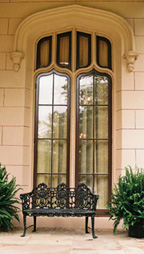 |

When William Wright Walker sold the Coxe-Topp estate on April 2, 1902, the deed was executed in St. Louis, and the buyer was a wealthy citizen of Pontiac, Michigan. For the sum of $2,100, covering notes that Walker owed the Bank of Holly Springs and the Merchants and Farmers Bank, the property was purchased by Albe A. Lull. The deed specified that the property was the same place now occupied by Dr. W. C. Elliott (DB 65:599-600).
Dr. Elliott was Lull's nephew, and when Lull made his will a year later, he left the Coxe-Topp estate to Dr. Elliott and his sister, Miss Fannie Elliot (WB 1:419-24). A colored postcard from the period preserves a view of Will Henry Coxes's now stark Gothic Villa. It bears the label, Sanitarium, Holly Springs, Miss. The Elliott family also occupied a part of the house as their residence.
The Elliotts were cultivated people of New England ancestry. Dr. Elliott's first wife, Agnes, died on June 19, 1902 and is buried in Hill Crest. She left a ten-year-old daughter, Jeanne. His second wife was a younger woman who was also a physician. She is likely only the second female member of the medical profession the town had been acquainted with the first being Dr. Anne Walter Fearn, daughter of Col. Harvey W. Walter. William C. Elliott's sister, Miss Fannie Elliott, was highly intellectual. It was remembered years later that when the family sold the house, the books she left behind had filled a cistern at Strickland Place. She was very much involved in activities of the Thursday Club.
It is the Elliotts who were responsible for the revival of the Gothic villa. In 1908 under the guidance of Holly Springs architect William W. Anderson, they renovated the house, painting the outside trim and the interior and putting across the front facade, again long porches of Gothic design. They made frame additions to the back of the mansion a room at the end of the central stair hall (where an ell-shaped back gallery had stood), a room at the end of the original one-story wing on the west, and, above the original bathroom, a room that opened into the southeast upstairs bedroom. Immediately behind the mansion, they constructed a two-story building. A chunk of foundation marked June 19, 1908, was discovered under these additions during the renovation in 2004.
In his memoir, The Day Caruso Died, the Reverend George Stephenson notes that he was born in 1909 in the Coxe mansion, which was then Dr. Elliott's small hospital. He recalls that in later years , while visiting his aunt next door (in the house that stood between Airliewood and Montrose), he and neighborhood children used to go over to handle the silver door knobs, pay our respects to the real skeleton in the closet, and find out how the swarm of bees in an upstairs bedroom were getting along by listening to a their thick hum through the wall.
After having rehabilitated the property and lived there for sixteen years, the Elliotts left Holly Springs. George Stephenson states that William Elliott died and his wife went to Serbia after World War I, but he is at least partially in error. The Elliotts may have separated or divorced. But William Elliot moved to Jacksonville, Florida, where he was still practicing in 1930 and where Jeanne Elliott married Clarence Foster. Their descendants visited the house, then occupied by the Dean family, in the 1960s.
On
June 15, 1918, Dr. William Elliott and Miss Fannie Elliot sold
the property, for $4,000 to W. G. Thompson (DB 74:250). The mansion
was once again in local hands. Walter Gray Thompson (1874-1928) was the
son of William Gray Thompson and Margaret Emma Scruggs, both Virginians
whose families had immigrated to Marshall County.
Walter Thompson's wife
was Laura Josephine Sigman, daughter of Ben Sigman and Virginia Small. Townspeople
still remember Mrs. Thompson's exceptionally sweet nature. She
was the mother of four children: Virginia, Loyd, Ben Sigman, and
Clementine (b. 1907). A photograph of the house taken about 1920
has confused a number of people because both Laura Sigman Thompson and
her daughter Clemmie are in period dress, perhaps clothing found in the
house.
Laura Sigman Thompson died in 1924, and the following year Mr. Thompson married in the parlor of what is now called the Doxey Cottage on Falconer Avenue, the artist Netty Glenn Fant (1878-1960). The daughter of Arthur Fant and Lizzie Anderson, she had been trained at the Art Institute in Chicago and the Art Students League in New York, but returned to Holly Springs to live with her mother, also an artist. She was for a time on the Chautauqua Circuit and a faculty member at Mississippi Synodical College.
Walter Gray Thompson died in June of 1928. Within a year, the old Coxe place again had new owners. The Great Depression loomed on the horizon, but the ensuing period in the history of the house was to be a charmed time.
THE LEAN YEARS | REVIVAL | THE DEAN YEARS | RESTORATION | NOTES